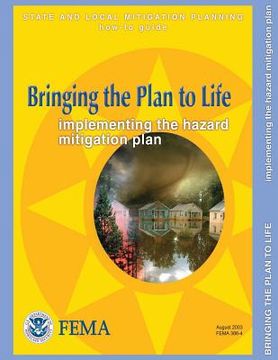Bringing the Plan to Life: Implementing the Hazard Mitigation Plan (State and Local Mitigation Planning How-To Guide; FEMA 386-4 / August 2003) (in English)
Synopsis "Bringing the Plan to Life: Implementing the Hazard Mitigation Plan (State and Local Mitigation Planning How-To Guide; FEMA 386-4 / August 2003) (in English)"
The Federal Emergency Management Agency (FEMA) has developed this series of mitigation planning "how-to" guides to assist states, tribes, and communities in enhancing their hazard mitigation planning capabilities. These guides are designed to provide the type of information states, tribes, and communities need to initiate and maintain a planning process that will result in safer and more disaster-resistant communities. These guides are applicable to states, tribes, and communities of various sizes and varying ranges of financial and technical resources. The how-to guides cover the following topics: Getting started with the mitigation planning process, including important considerations for how you can organize your efforts to develop an effective mitigation plan (FEMA 386-1); Identifying hazards and assessing losses to your community, tribe, or state (FEMA 386-2); Setting mitigation priorities and goals for your community, tribe, or state and writing the plan (FEMA 386-3); Implementing the mitigation plan, including project funding and maintaining a dynamic plan that changes to meet new developments (FEMA 386-4); Evaluating and prioritizing potential mitigation actions through the use of benefit-cost analysis and other techniques (FEMA 386-5); Incorporating special considerations into hazard mitigation planning for historic structures and cultural resources (FEMA 386-6); Incorporating mitigation considerations for manmade hazards into hazard mitigation planning (FEMA 386-7); Using multi-jurisdictional approaches to mitigation planning (FEMA 386-8); and Finding and securing technical and financial resources for mitigation planning (FEMA 386-9). This guide will address the following questions: 1. How can we make sure the plan is officially recognized? Proof of formal adoption is required under DMA 2000 regulations. Getting the plan adopted ensures the support and approval of the governing authority in your jurisdiction. 2. What is the most effective mechanism to implement each recommendation? What resources are available? How can we keep the public informed and actively involved now that initiatives are underway? Your mitigation strategy probably contains various short- and long-term recommendations. The actual sources of funding, staff time, and staffing needs may change before project implementation gets underway. The planning team always must be on the lookout for alternative sources of funding, new opportunities, and new partnerships through which to carry out the recommendations. Determining who will bear responsibility for implementing planned actions is key to getting the implementation phase off to a successful start. 3. How will we know if our mitigation strategy is working? Monitoring and evaluating the outcomes of the mitigation actions are essential to knowing whether to stay the course or change it. The successes and limitations of your efforts should be documented as part of the evaluation process. Celebrating successes and keeping citizens actively involved and informed of the progress of the hazard mitigation initiatives, are just as important in the adoption, implementation, and revision phases as in any other phase. Keeping everyone up to date on progress also will help sustain support for mitigation as a local, tribal, or state priority. 4. When should we reexamine the plan? The community and its assets are constantly changing, requiring the mitigation plan to be updated periodically. While DMA 2000 regulations require a formal review and revision of the community plan once every five years for local jurisdictions and every three years for states, the planning team should reevaluate its implementation strategy as new opportunities, unforeseen challenges, and disasters arise. As mitigation issues are resolved, the plan should be reexamined to determine whether there is a need to reprioritize, add, or reconfigure actions in light of what has been accomplished.

